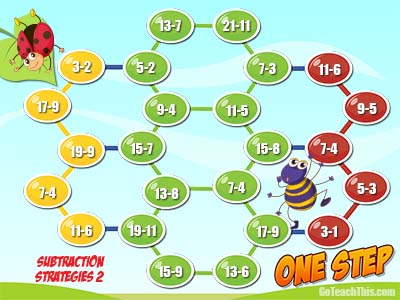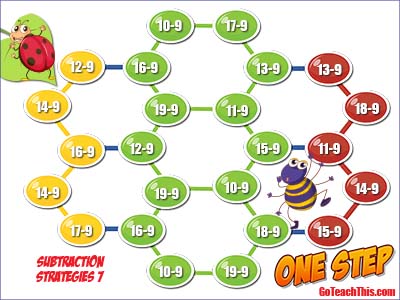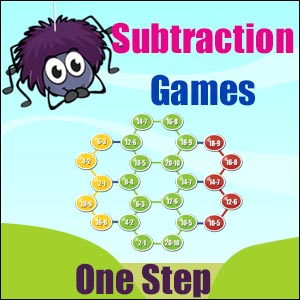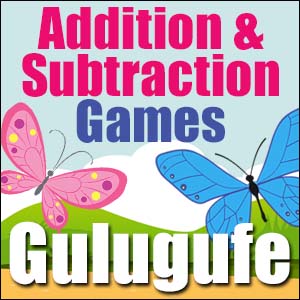Subtraction Strategy Game – One Step
Subtraction Strategy Game – One Step is a series of seven game boards designed to encourage students to practice efficient strategies for solving subtraction algorithms. As a bonus, the game requires the students to consider the best tactical strategies to win the game.
$4.80
Subtraction Strategy Game
One Step

Subtraction Game – One Step
Subtraction Strategy Game:
One-Step is a series of seven-game boards designed to encourage students to practice efficient strategies for solving subtraction algorithms. As a bonus, the game requires the students to consider the best tactical strategies to win the game.
Students move their counters one step at a time on the game board and provide the correct solution to the algorithm on the ellipse they landed on. The object of the game is for one player to get all their counters to their opponent’s home base.
Aim:
Through gameplay and discussion, students will come to appreciate the many and varied strategies that can be used to solve subtraction algorithms.
What You Need:
2 players
1 game board
5 counters of one color
5 counters of a different color
How to Play:
1. Play a game of Rock, Paper, Scissors to decide which player will go first. (Or Scissors, Paper, Rock, Lizard, Spock for the Big Bang Theory fans)
2. Player 1 chooses which side of the board will be their home base.
3. Player 1 and Player 2 place all 5 counters of their counters on the red or yellow home base positions.
4. Player 1 begins the game by moving one of their counters ‘one step’ then’ saying the answer algorithm underneath the counter. If the answer is correct they remain on the game space, if incorrect the counter moves back to its previous position.

Subtraction Practice Game – Low Color Versions
Possible Playing Option:
Part of the gameplay could be for students to orally recount the strategy they used to arrive at the answer e.g. ‘I used my knowledge of Addition Facts to solve this.’ ‘I counted backward two’ Decide this based on student need.
5. Player 2 takes their turn to move ‘one step’ and solve the algorithm.
6. Players are only permitted to move backward and forwards, they cannot jump over or land on their opponent’s counter. This is where strategy comes into play as there will be times an opponent’s counter will be blocking a movement.
7. Play continues in this turnabout fashion until the game is won.
How to Win:
The winner is the first player to have all 5 of their counters on their opponent’s home base positions and have correctly answered all home base algorithms.
Boards and Strategy Overview:
Board 1 Strategy: Doubles – use your knowledge of Addition Doubles Facts to solve the Subtraction Facts. How might this be done?
Board 2 Strategy: Doubles + One discussion/challenge- How can you ‘change around’ your knowledge of Doubles Plus One Addition Facts to solve these algorithms.
Board 3 Strategy: Think ‘ Use Addition to Solve Subtraction Problems’ – Explore the strategy of Building Through 10. NB, it is possible to use a variety of strategies on this game board. It is designed to invite discussion and experimentation.
Board 4 Strategy: Think Number Bonds to 10 / Friends of 10 or subtract from 10.
Board 5 Strategy: Think Number Bonds to 20 or Friends of 20 (single digit answers).
Board 6 Strategy: Think Number Bonds to 20 or Friends of 20 (double-digit answers).
Board 7 Strategy: When subtracting 9 think, ‘Subtract 10 and add 1’
Before the Game:
- Introduce and discuss the possible strategies to be used to solve the algorithms on the board about to be played.
- Teacher models their personal self talk when solving algorithms so the students hear how to solve algorithms efficiently.
- Discuss each strategy and ask students to consider which one to use and when?
NB for a strategy to be considered ‘good’ in Math it needs to be, “accurate, efficient and replicable” (easy to do again by others)
- Give students opportunities to practice basic subtraction facts using a variety of strategies from and to 20. The aim here is to provide students with greater confidence for gameplay and to reinforce strategies other than counting backward.
- Have students practice orally recounting/retell strategies used to solve subtraction problems.
- To differentiate this game you might like to consider providing small number lines as a scaffold to some students to build their confidence and enjoyment of the game.
During the Game:
- Monitor the strategies students use to solve algorithms and note any areas for future remediation.
- Ask students to consider what strategies they are using to solve the algorithm. What strategies work the best? Could there be a more efficient way to solve it? Are the answers you get from using your strategy accurate? Is your strategy easy for others to replicate?
- Several game boards invite students to consider more than one strategy. Ask students to consider the strategy they are using. Is there another way? Is it ‘better’ than the strategy you used?
Possible Extension Activities:
- Once a few game board variations have been played, ask students which subtraction strategy works best? Is there one or do you need to select the best strategy for the algorithm? Which strategy did you use and why?
- Once students are familiar with all the various strategies consider ringing a bell and switching the strategy they are allowed to use during gameplay. Include counting up and back as this will also aid in the discussion of efficient strategies following the game. But be sure to bring to their attention counting backward and forwards is only really efficient for one, two & maybe three. After that, strategies are the most efficient.
After the Game:
- Ask students to consider why counting back or up is not always the ‘best’ strategy even though it will give the correct answer.
- Ask students to consider how each strategy meets the criteria of being efficient, accurate & replicable.
- Discuss with students if going first makes a difference to the outcome of the game.
- Ask students to consider gameplay strategies, how do you choose which counter to start with? What are your tactics if your path is blocked by your opponent’s counter?
- Students record their observations and reflections from the above questions and investigations in a Math Journal.
EXPLORE MORE




